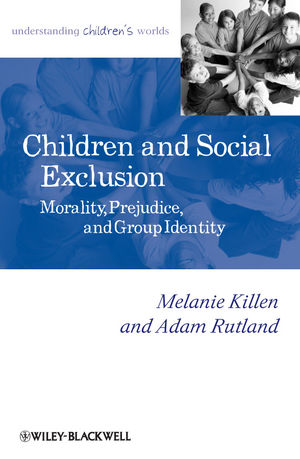Children and Social Exclusion: Morality, Prejudice, and Group IdentityISBN: 978-1-4051-7651-4
Hardcover
246 pages
May 2011, Wiley-Blackwell
 This is a Print-on-Demand title. It will be printed specifically to fill your order. Please allow an additional 10-15 days delivery time. The book is not returnable.
|
||||||
Preface xiii
Chapter 1 Introduction: Exclusion and Inclusion in Children’s Lives 1
Theories of Social Cognition, Social Relationships, and Exclusion 3
Types of Exclusion 6
Goals of the Book 7
Summary 7
Chapter 2 The Emergence of Morality in Childhood 9
Morality in Childhood 10
What Morality is Not 10
Criteria, Definitions, and Measurements of Morality 11
Morality Encompasses Judgment, Emotions, Individuals, and Groups 12
Social Precursors of Moral Judgment 13
Moral Judgment and Interaction in Childhood 19
Morality as Justice 23
Social Domain Model of Social and Moral Judgment 25
Moral Generalizability 30
Morality in the Context of Other Social Concepts: Multifaceted Events 32
Morality and Theory of Mind 34
Morality and Social-Cognitive Development 35
Summary 35
Chapter 3 Emergence of Social Categorization and Prejudice 37
Social Categorization as a Precursor of Prejudice 38
Explicit Biases in Young Children 44
Cognitive Developmental Approach to Prejudice Development 47
Development of Implicit Biases 50
Relation of Implicit Bias to Judgment and Behavior: Is it Prejudice? 53
Summary 57
Chapter 4 Group Identity and Prejudice 59
Is Group Identity Good or Bad? 60
Social Identity Theory 62
Social Identity Development Theory 64
Theory of Social Mind and the Control of Prejudice 68
Moral or Group Norms and the Control of Prejudice 70
Processes Underlying the Control of Prejudice 73
Developmental Subjective Group Dynamics 77
Morality and Group Identity 81
Summary 84
Chapter 5 What We Know about Peer Relations and Exclusion 86
Intrapersonal and Interpersonal Exclusion: Social Traits and Individual Differences 87
Intragroup and Intergroup Exclusion: Ingroup/Outgroup Identity 90
Social Reasoning and Exclusion 92
Gender Exclusion in Early Childhood: Okay or Unfair? 94
Comparing Gender and Racial Exclusion: Group Goals and Qualifications 97
Interviewing Ethnic Minority and Majority Children and Adolescents about Exclusion 100
Social Reasoning about Exclusion in Adolescence: Crowds, Cliques, and Networks 108
Social Reasoning about Sexual Prejudice 108
Exclusion in Interracial Encounters: Lunch Table, Birthday Parties, and Dating 109
Gender Exclusion in the Family Context: Children’s Views about Parental Expectations 113
Summary 116
Chapter 6 Intragroup and Intergroup Exclusion: An In-depth Study 118
Group Dynamics: Conceptions of Groups in the Context of Exclusion 118
Group Dynamics: Group Identity, Group-Specific Norms, Domain-Specific Norms 119
Group-Specific Norms 123
Deviance in Social Groups 123
Group Identity 124
Implications for Group Identity in Childhood 132
Summary 132
Chapter 7 Peer Exclusion and Group Identity Around the World: The Role of Culture 134
Cultural Context of Exclusion 136
Long-Standing Intergroup Cultural Conflicts 137
Cultures with Intractable and Violent Conflict 138
Recently Immigrated Groups 143
Intergroup Exclusion Based on Indigenous Groups 151
Summary 152
Chapter 8 Increasing Inclusion, Reducing Prejudice, and Promoting Morality 154
Intergroup Contact and Reducing Prejudice 156
Intergroup Contact and Children 157
Cross-group Friendships and Prejudice 158
Intergroup Contact and Minority Status Children 163
Reducing Implicit Biases through Intergroup Contact 165
Reducing Prejudice through Extended Intergroup Contact 166
Promoting Inclusion through the Mass Media 171
Intergroup Contact and Promoting Moral Reasoning in Children 174
Multicultural Education and Social Exclusion 176
Factors that Reduce Childhood Bias 178
Summary 180
Chapter 9 Integration of Morality, Prejudice, and Group Identity: A New Perspective on Social Exclusion 181
Theories about Peer Relationships 181
Theories about Social Exclusion 183
Children as Active Participants 185
Judgments, Beliefs, Attitudes, Attributions of Emotions, and Behavior 187
Implicit and Indirect Measures of Prejudice and Exclusion 190
An Integrative Social-Cognitive Developmental Perspective on Social Exclusion 191
Social Experience Factors that Promote Inclusion 192
Exclusion and Prejudice 193
Summary 193
References 197
Index 223



